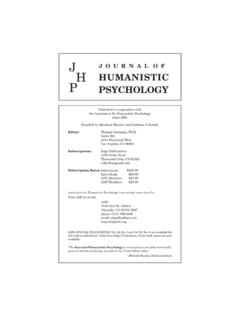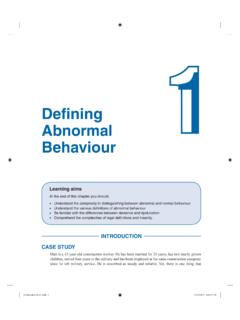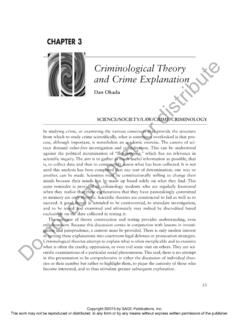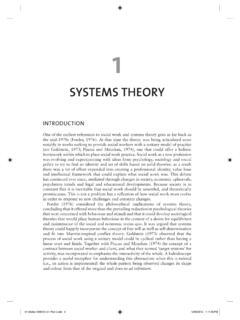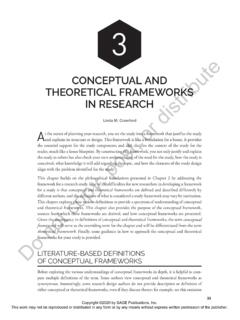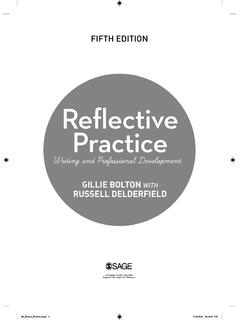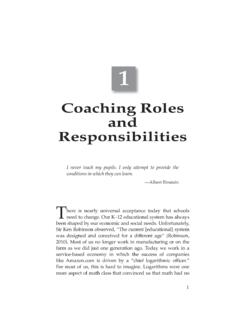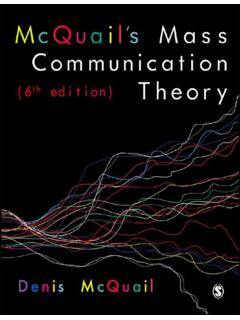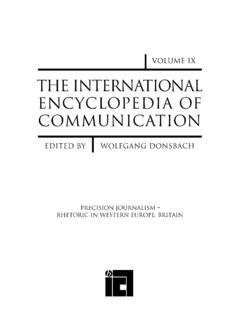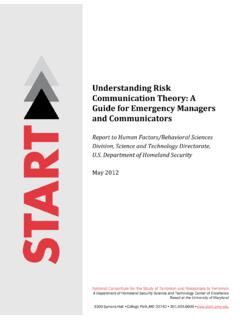Transcription of McQuail’s Mass Communication Theory
1 McQuail s mass Communication Theory4 Theory of Media and SocietyMedia, society and culture: connections and confl icts 80 mass Communication as a society-wide process: the mediation of social relations and experience 82A frame of reference for connecting media with society 85 Theme I: power and inequality 87 Theme II: social integration and identity 89 Theme III: social change and development 91 Theme IV: space and time 93 Media society Theory I: the mass society 94 Media society Theory II: Marxism and political economy 95 Media society Theory III: functionalism 98 Media society Theory IV: social constructionism 100 Media society Theory V: Communication technology determinism 101 Media society Theory VI: the information society 104 Conclusion 107 Theories80In this chapter, we look more closely at ideas about the relation between mass media and society, reserving the cultural implications for Chapter 5, even though society and culture are inseparable and the one cannot exist without the other.
2 Treating society first also implies a primacy for society that is questionable, since the media and what they produce can also be considered as part of culture . In fact most media Theory relates to both society and culture together and has to be explained in relation to both. For present purposes, the domain of society refers to the material base (economic and political resources and power), to social relationships (in national societies, communi-ties, families, etc.) and to social roles and occupations that are socially regulated (for-mally or informally). The domain of culture refers primarily to other essential aspects of social life, especially to symbolic expression, meanings and practices (social customs, institutional ways of doing things and also personal habits).Most of the chapter is concerned with explaining the main theories or theoretical perspectives that have been developed for understanding the way media work and accounting for the typical cultural production that they engage in.
3 Most of these theo-ries do make the assumption that material and social circumstances are a primary determinant, but there is also scope for recognizing the independent influence that ideas and culture can have in their turn on material conditions. Before the theories of media and society are considered, the main issues or broad themes that have framed inquiry into mass Communication are described. A general frame of reference for look-ing at the connections between media and society is also proposed. First of all, we return in more detail to the conundrum of the relation between culture and , Society and Culture: Connections and ConflictsMass Communication can be considered as both a societal and a cultural phenom-enon. The mass media institution is part of the structure of society, and its techno-logical infrastructure is part of the economic and power base, while the ideas, images and information disseminated by the media are evidently an important aspect of our culture (in the sense defined above).
4 In discussing this problem, Rosengren (1981b) offered a simple typology which cross-tabulates two opposed propositions: social structure influences culture ; and its reverse, culture influences social structure . This yields four main options that are available for describing the relation between mass media and society, as shown in Figure we consider mass media as an aspect of society (base or structure), then the option of materialism is presented. There is a considerable body of Theory that views culture as dependent on the economic and power structure of a society. It is assumed that whoever owns or controls the media can choose, or set limits to, what they do. This is the essence of the Marxist we consider the media primarily in the light of their contents (thus more as culture), then the option of idealism is indicated. The media are assumed to have a Theory of Media and Society81potential for significant influence, but it is the particular ideas and values conveyed by the media (in their content) which are seen as the primary causes of social change, irrespective of who owns and controls.
5 The influence is thought to work through indi-vidual motivations and actions. This view leads to a strong belief in various potential media effects for good or ill. Examples include the promotion by the media of peace and international understanding (or having the opposite effect), of pro- or antisocial values and behaviour, and of enlightenment or the secularization and modernization of traditional societies. A form of idealism or mentalism concerning media also lies behind the view that changes in media forms and technology can change our way of gaining experience in essential ways and even our relations with others (as in the theories of McLuhan 1962, 1964).The two options remaining of interdependence and of autonomy have found less distinctive theoretical development, although there is a good deal of support in common sense and in evidence for both. Interdependence implies that mass media and society are continually interacting and influencing each other (as are society and culture).
6 The media (as cultural industries) respond to the demand from society for information and enter-tainment and, at the same time, stimulate innovation and contribute to a changing social-cultural climate, which sets off new demands for Communication . The French sociologist Gabriel Tarde, writing about 1900, envisaged a constant interweaving of influences: technological developments made newspapers possible, newspapers promote the for-mation of broader publics, and they, by broadening the loyalties of their members, cre-ate an extensive network of overlapping and shifting groupings (Clark, 1969). Today, the various influences are so bound together that neither mass Communication nor modern society is conceivable without the other, and each is a necessary, though not a sufficient, condition for the other. From this point of view we have to conclude that the media may equally be considered to mould or to mirror society and social (two-wayinfluence)Idealism(strong mediainfluence)Materialism(media aredependent)Autonomy(no casualconnection)NoNoSocial structureinfluences cultureYesYesCulture influencessocial structureFigure Four types of relation between culture (media content) and societyTheories82 The option of autonomy in the relations between culture and society is not necessar-ily inconsistent with this view, unless interpreted very literally.
7 It is at least very likely that society and mass media can be independent of each other up to a point. Societies that are culturally very similar can sometimes have very different media systems. The autonomy position also supports those who are sceptical about the power of the media to influence ideas, values and behaviour for instance, in allegedly promoting conform-ity, stimulating modernity or damaging the cultural identity of poorer or less powerful countries. There are different views about how much autonomy in relation to society the media can have. The debate is especially relevant to the central thesis of interna-tionalization or globalization , which implies a convergence and homogenization of a worldwide culture, as a result of the media. The autonomy position would suggest that imported media culture is superficial and need not significantly touch the local culture. It follows that cultural imperialism is not likely to happen simply by chance or against the will of the culturally colonized (see Chapter 10).
8 An inconclusive outcomeAs with many of the issues to be discussed, there are more theories than there is solid evidence, and the questions raised by this discussion are much too broad to be settled by empirical research. According to Rosengren (1981b: 254), surveying what scattered evidence he could find, research gives only inconclusive, partly even contradictory, evidence about the relationship between social structure, societal values as mediated by the media, and opinions among the public . This assessment is just as valid thirty years later, suggesting that no single Theory holds under all seems that the media can serve to repress as well as to liberate, to unite as well as to fragment society, to promote as well as to hold back change. What is also striking in the theories to be discussed is the ambiguity of the role assigned to the media.
9 They are as often presented in a progressive as in a reactionary light, accord-ing to whether the dominant (pluralist) or alternative (critical, radical) perspective is adopted. Despite the uncertainty, there can be little doubt that the media, whether moulders or mirrors of society, are the main messengers about society, and it is around this observation that the alternative theoretical perspectives can best be Communication as a Society-wide Process: the Mediation of Social Relations and ExperienceA central presupposition, relating to questions both of society and of culture, is that the media institution is essentially concerned with the production and distribution of knowl-edge in the widest sense of the word. Such knowledge enables us to make some sense of our experience of the social world, even if the taking of meaning occurs in relatively autono-mous and varied ways.
10 The information, images and ideas made available by the media may, for most people, be the main source of an awareness of a shared past time (history) and of ** Theory of Media and Society83a present social location. They are also a store of memories and a map of where we are and who we are (identity) and may also provide the materials for orientation to the future. As noted at the outset, the media to a large extent serve to constitute our perceptions and defi-nitions of social reality and normality for the purposes of a public, shared social life, and are a key source of standards, models and main thing to emphasize is the degree to which the different media have come to be interposed between ourselves and any experience of the world beyond our imme-diate personal environment and our direct sensory observation. They also provide most of us with the main point of contact with the institutions of the society in which we live.

